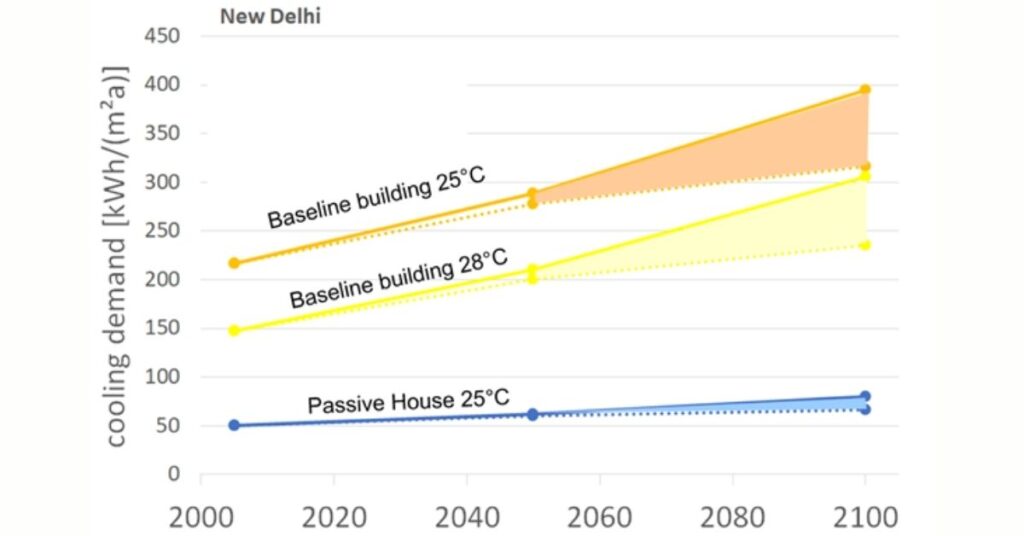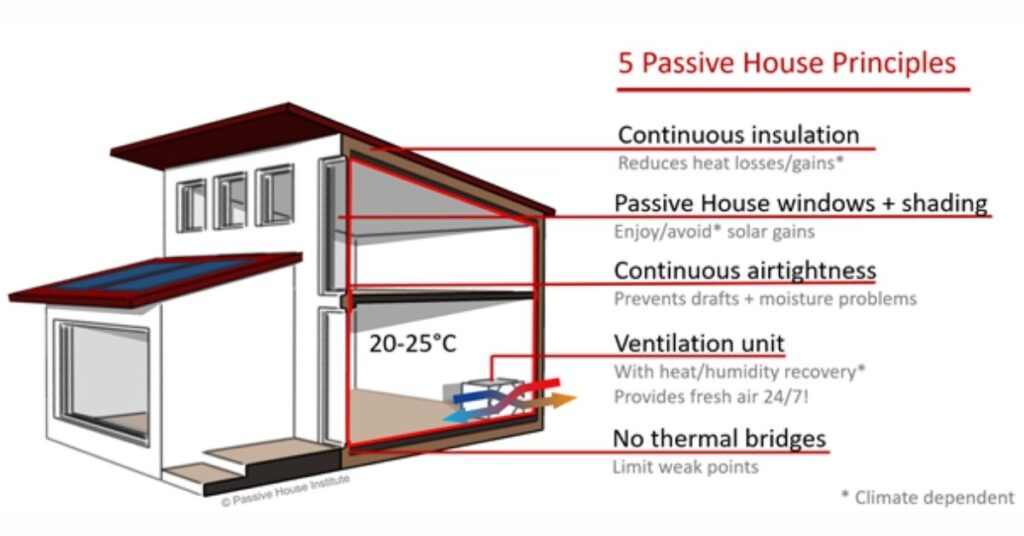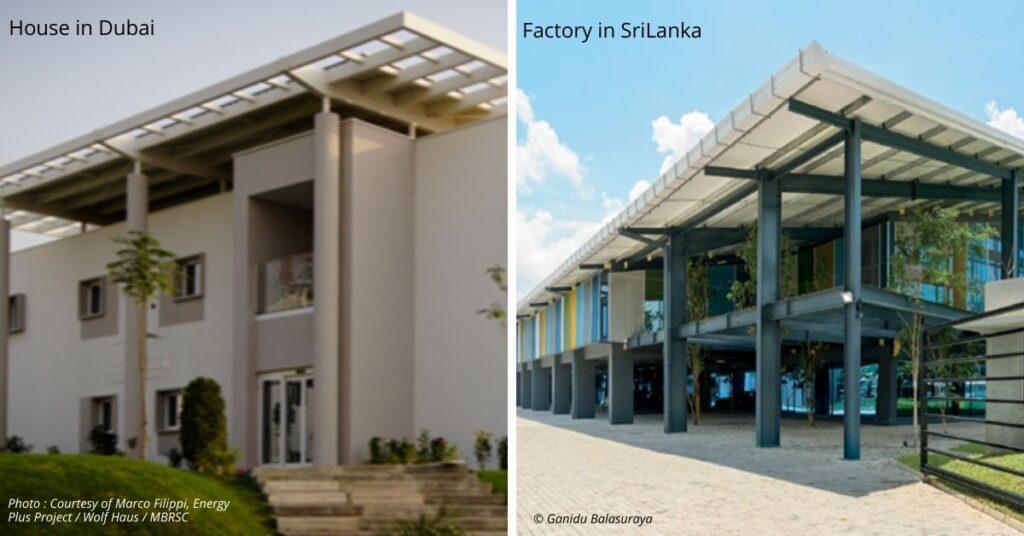The Passive House approach for warm climates
Naman Sukhija | Designer, Passive House Institute
Passive House is an internationally recognized, performance-based energy standard in construction. The Passive House concept is based on the goal of reducing heat transfer across building envelope to an absolute minimum, thus rendering large cooling and heating systems unnecessary. This approach ensures thermal comfort with the least energy use possible. Energy optimization is done considering the boundary conditions of internal temperature of 20°C for winters and 25°C for summer. The Passive House (PH) standard applies the comfort definition according to the international standard ISO 7730 (PMV method).
Rising global temperatures escalate the concern of cooling demand. As an example, Figure 1 shows calculated annual cooling demand of about 175 kWh/sqm for 2021 for a baseline multi-family building in New Delhi, which is already very high even if operated at 28°C (lower comfort level) space temperature. If the operational temperature is reduced to 25°C, the annual cooling demand increases by more than 40%. A Passive House for the same location will have annual cooling demand of about 52 kWh/sqm to provide an indoor temperature of 25°C. The graph also shows an eight-fold increase in cooling demand by the year 2100 for the baseline building to maintain the comfort level of 25°C compared to a Passive House. Notice that the Passive House building shows a negligible increase in cooling demand for a future scenario. This is because the thermal envelope in a Passive House building is more resilient to future climate projections.

Passive House standard follows a “passive-first” approach to ensure thermal comfort inside a building. This means, before considering releasing the heat into the environment using a mechanical air-conditioning system, the primary focus is on reducing the heat build-up inside the building. The following five basic principles apply for the construction of Passive Houses that ensure a sharp reduction in cooling and consequently energy demand of the building.

1) Thermal insulation
Thermal insulation has been proven to be useful in every climate. An efficient thermal envelope not only reduces the transmission gains but also helps in keeping the “generated cold” inside the building in warm climates. The thickness of the insulation required is dependent on the climate and compactness of the building. PHPP (Passive House Planning Package) also gives a starting point for the optimization of the U-Values for walls and roof for the project. High thermal mass has also shown to be helpful in warmer climates as it dampens the peak temperatures and also reduces the average temperature levels. If the building envelope is exposed to a lot of solar radiation, then using high solar reflective materials (cool colour) for the exterior surfaces is recommended to maximize the reflectance of the solar radiation.
2) Passive House windows and shading
Efficient window frames with low thermal conductivity in combination with glazing having low solar transmittance and thermal conductivity should be considered in warm climates. The window frames must be well insulated and fitted with Low-E glazing filled with argon or krypton to prevent heat transfer. Apart from many other building components, Passive House Institute also certifies windows for the respective climates to ease the building certification process in respect to the PH standard.
Nearby shading objects (buildings, trees & etc.), the lateral reveal of the windows, overhangs and temporary shading (blinds, awnings & etc.) are considered for the shading calculations for winters and summers. Temporary external shading like roller blinds or awnings should be used. These can be manually or automatically controlled depending upon the requirement. External shading is more effective than internal shading, as in the latter case the solar radiation has already entered inside the building.
3) Ventilation with heat/humidity* recovery
Efficient heat/humidity* recovery ventilation is key, allowing for good indoor air quality and saving energy. In Passive House, the heat from the incoming fresh air is transferred to the exhaust air by means of a heat exchanger. If required, energy recovery ventilators can be used to take heat and humidity out of the fresh air before it enters the building, thus reducing the cooling demand passively. Considering the poor air quality index in many major metro cities in India, mechanical ventilation has become even more important. This can also be coupled with an efficient passive air-cooling technique to further increase the efficiency of the ventilation system. If the temperature is significantly lower at night with comfortable humidity levels, night ventilation can also be introduced using windows or the mechanical ventilation system. In many regions in India, ceiling fans are also used for local thermal comfort by the air movement but they do not directly influence the humidity level or temperature of the air.
* Climate dependent
4) Airtightness of the building
Airtightness is a very important measure to minimize any infiltrations from the building envelope in mixed-mode or actively-cooled buildings and thus also protecting the construction from moisture damages. Air change rate must be smaller than 0.6 h-1 of the total house volume per hour during an airtightness test (blower-door method) at 50 Pascal (both pressurised and depressurised).
5) Absence of thermal bridges
All edges, corners, connections and penetrations must be planned and executed with great care so that thermal bridges can be avoided. Thermal bridges which cannot be avoided must be minimised as far as possible. The insulation layer should be continuous to minimize thermal bridges. One common example is the cantilevered balcony slabs which can be a significant thermal bridge. Instead, balcony connections with thermal breaks can be a solution to minimize the heat transfer.
The standard has been adopted and tested around the world for various building types. For example, the project shown in Figure 3 achieved a cooling load of 9.7 W/m2 for the hot & humid climate of Dubai and a factory building in hot & humid climate of Colombo, Sri Lanka achieved 21 W/m2.

Several monitoring studies have also been done showing that there is no performance gap between the design and operation of a Passive House.
Electric appliances inside the building also contribute to the internal heat gains (IHG). It has become more affordable than ever to reduce the lighting power density of the building as the costs for LED lighting has reduced tremendously in the last years. Ceiling fans provide local comfort, however, they also contribute to IHG, so efficient ones should be chosen. The Bureau of Energy Efficiency (Government of India) has a rating system for the efficiency of the electric appliances which should be used to compare the products at the time of procurement to select highly efficient components.
After these steps, an efficient mechanical air-conditioning system can be incorporated to ensure thermal comfort in extreme climates, since, the size of the system will be relatively much smaller at this stage. As the total energy demand of the building is very low, it becomes much easier to meet the remaining energy demand using renewable energy. This makes the Passive House standard a very suitable approach for the Net-Zero Energy or even Net-Positive energy goals.
As a quality-assurance approach, the implementation of the PH standard should be verified using the Passive House Planning Package (PHPP) and the building certification scheme developed by the Passive House Institute. It is also believed that as the demand for energy-efficient components will increase in India, more components will be manufactured locally which will ease the accessibility and lower the costs, as has already been witnessed in Europe and North America. Many PH certified buildings are already being built in the warm and tropical climate of the world. The Passive House concept itself remains the same for all of the world’s climates, as does the physics behind it. Built examples around the world clearly show that the details do have to be adapted to the specific climate and country.
